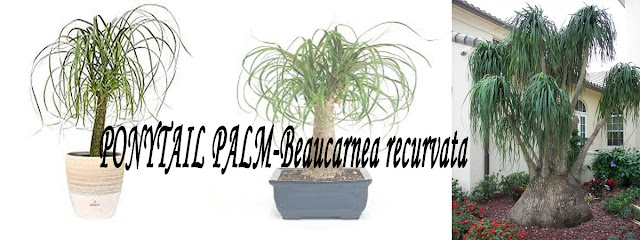PONYTAIL PALMS (BEAUCARNEA RECURVATA)
Ponytail Palms, otherwise called Elephant’s Foot and Bottle Palm, are some kind of succulents. Botanical name for PONYTAIL PALMS is (BEAUCARNEA RECURVATA) . They are unique in character, indoor plant that thrives on benign forget. They are very easy to grow, but shouldn’t over water them! Here’s the right way to develop and maintain a ponytail palm in your house. Even with the title and palm-like look, the ponytail palm isn't a true “palm.” In fact, it is more carefully similar to desert plants in the Agave and Yucca genera (e.g., Joshua trees).
The standard ponytail palm consists of a large, domed “stump,” which tapers off into a thinner stem. From the highest of the stem, one or more rosettes of lengthy, green, leathery leaves develop because the plant ages. Indoors, the leaves can rise up to three toes long, however outdoor, they are also double that duration.
Its native place is eastern Mexico, as all the plants have been identified to succeed in up to 30 toes in top! However, ponytail hands which are grown in gardens as landscape plants are not taller than 10 feet (ca. 3 m) tall. If we grow ponytail palm indoors, they will not grow rarely taller than 4 ft(1.22 m).
Care of this plant is in most cases are very easy and simple; the most typical issue is the watering behavior to its watering needs!
The leaves are not soft, but they are much less stiff and thorny than typically anticipated from an agave. Those leaves sprout from the top of the stem in a fountain-like manner and glance somewhat like ponytails. Because of the plant’s broad, grayish base with cracking bark, ponytail hands are often referred to as “elephant foot trees.” The base of each and every ponytail palm tapers as much as a narrow, swish trunk, which is why a common title for this plant is “bottle palm.” The gardeners in zones 10 and 11 can develop them outside in well-drained, sunny areas, the place they can succeed in as much as 20 toes tall.
PLANTING
FINDING SOIL AND A POT
• Use a quick draining soil, reminiscent of a cacti and succulent potting mix. If you've got potting soil, sand, and perlite already readily available, you can create your personal desolate tract soil mixture: Simply combine 1part potting soil, 1 phase perlite, and 1 section sand.
• Select a pot that has a hollow within the bottom, so that extra water will also be drained off. Ponytail fingers do not like to sit down in wet soil for very lengthy.
• Use a clay pot if conceivable; the porous material will absorb one of the most water, drying out the soil more quickly (a good factor for cacti and succulents).
CARE
HOW TO CARE FOR PONYTAIL PALMS
• Ponytail arms wish to have as much mild as possible, so position the plant in a bright location. Bright, oblique sunlight is easiest.
• Keep the potting base soil slightly dry. Water from spring through fall, allowing the highest inch or two of soil to dry completely prior to re-watering. During winter, water once in a while.
• To water, soak the soil and make allowance the excess water to drain throughout the bottom of the pot right into a dish. Let the pot sit in the dish for a number of minutes, then sell off out any ultimate water within the dish.
• Fertilize in the spring with a cacti/succulent fertilizer and produce right into a brighter room for the summer months.
• Normal room temperature is ok for many of the year, but keep the plant slightly cooler in the winter (50-55°F / 10-13°C) to copy the natural dormancy cycle.
• During winter, don’t let the plant sit down too with reference to cold home windows at evening, as it maybe critically broken via freezing temperatures.
REPOTTING A PONYTAIL PALM
• If the Ponytail palms are potted in a small pot,it will stay small . They can cross for a few years earlier than wanting to be repotted. Repotting each and every different 12 months on the most is all a ponytail palm needs.
• Moving the plant to a bigger pot will give it room to develop in each peak and girth. However, older crops might turn into difficult to manage because of their sheer size and weight if no longer kept at the smaller measurement.
•When deciding on a brand-new pot, pick out one large enough to go away about an inch or so of space between the ponytail palm’s trunk and the rim of the pot.
• Note: very careful when handling a ponytail palm, as its leaves have tiny serrated harsh edges.
PESTS/DISEASES
• Over watering may end up in stem rot. If you withhold watering, the plant may be able to internally treatment the issue. Signs of stem rot come with yellowing leaves and a caudex (the plant’s base and stem) this is soft or squishy.
• Spider mites occur on the leaves, however will also be handled through rubbing a fabric of dish soap and water at the stems. Spider mites are evidenced by the presence of spider-like webbing at the plant.
• Brown tips about leaves can be a signal of over fertilizing or under watering, so alter your husbandry practices correctly. They can also be a sign that the plant is getting too much direct daylight and too little water.
HARVEST/STORAGE PROPAGATION
• Rarely, a ponytail palm would possibly produce an offset—a small child plant that stems from the bottom of the grownup plant. These will also be bring to an end at the base after they achieve a minimum of 4 inches in top and planted in a succulent potting mix. Before planting, permit the minimize wound to heal, then observe slightly of rooting hormone (available on-line and in nurseries) to inspire the offset to root.
WIT & WISDOM
• The plant’s abnormal form and colour has granted it some other bizarre nickname: the Elephant’s Foot Palm.




Comments
Post a Comment